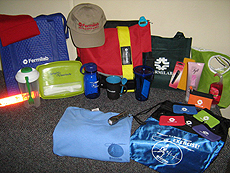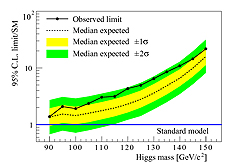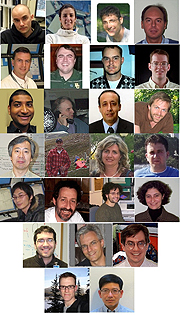|
Thursday, July 26
- Breakfast: Apple sticks
- Tomato Florentine
- Barbecue pork sandwich
- Smart cuisine: kielbasa & sauerkraut
- Smart cuisine: chicken marsala
- Smoked turkey melt
- Assorted sliced pizza
- Southwestern chicken salad w/ roasted-corn salsa
Wilson Hall Cafe Menu |
|
Friday, July 27
Dinner
- Cranberry & walnut salad
- Pan-roasted monkfish w/ red-wine sauce
- Wild mushroom stuffed potatoes
- Sautéed spinach
- Pear tart
Wednesday, August 1
Lunch
- Bloody Mary chopped salad w/shrimp
- Cold lime soufflé
Chez Leon Menu
Call x3524 to make your reservation.
|
|
August wellness offerings, fitness classes, employee clubs and discounts
Fitness class:
- Kyuki-do martial arts class meets Mondays and Wednesdays, Aug. 6 to Sept. 12, from 5 to 6 p.m. at the Fitness Center.
$55 per person.
- Muscle toning class meets Tuesdays & Thursdays, Aug. 7 to Oct. 2, (no class on Sept. 27) from 5:30 to 6:30 p.m. at the Fitness Center.
$77 per person.
- Yoga class meets
Tuesdays, Aug. 28 to Oct. 16, from noon to 1 p.m. in Ramsey Auditorium.
$85 per person.
Employee club:
- The Fermilab Singers are preparing for their end-of-summer concert. All are welcome to join. The Singers meet on Wednesdays from noon to 1 p.m. in Ramsey Auditorium. For more information, e-mail Anne Heavey at aheavey@fnal.gov.
Featured employee discounts:
- Bristol Renaissance Faire
- Journey Cycle and BMX
- Raging Waves Waterpark
- Fermi Days at Six Flags Great America
- Any Day tickets at Six Flags Great America
For more information, e-mail Jeanne Ecker in the Wellness Office at jkoester@fnal.gov.
|
Accelerate to a Healthy Lifestyle program
 |
|
ES&H awards prizes based on participation every month. Photo: Cindy Rogers, ES&H
|
Mark your calendars. ES&H's 4th annual Accelerate to a Healthy Lifestyle program kicks off Aug. 1 and runs through Oct. 31.
Participants in the program aim to exercise a minimum of three times per week for 30 minutes. Exercise can include walking, running, playing tennis, swimming, biking, hiking and other activities.
For more information, please visit the ES&H webpage, where you can join and enter your time electronically.
|
Going where the beam is good
From physicsworld.com, July 25, 2012
This has been a fantastic year for high-energy physics. The long wait for the Higgs boson appears, finally, to be over, and with CERN's Large Hadron Collider (LHC) churning out unprecedented numbers of data, more discoveries seem just around the corner. But for some members of the community, these successes are bittersweet. The closure of the Tevatron collider – once an American rival to Europe's LHC – in September 2011 signalled the end of an era for particle physics in the US, and forced many researchers at Fermilab, the Tevatron's home, to rethink their career plans. Should they change fields? Move to CERN and the LHC? Or just get used to flying across the Atlantic a lot?
I travelled to Fermilab and CERN to learn more about the changing geography of high-energy physics and how it affects individual researchers. In this behind-the-scenes podcast, you'll hear senior scientists and early-career researchers talking candidly about their working lives, their reactions to the Tevatron's shutdown and their plans for the future.
Read more
|
Cuts loom for US science
From Nature, July 24, 2012
In an ordinary year, a flat budget for the US National Institutes of Health (NIH) would be considered dire news. This year, it is far from the worst possible outcome. Hanging over the effective decrease in support proposed by the House of Representatives last week is the 'sequester', a pre-programmed budget cut that research advocates say would starve US science-funding agencies.
A sharply divided Congress is showing few signs that it can defuse the situation before the self-imposed fiscal time bomb explodes, in less than six months' time. And even if Congress does manage to introduce last-minute legislation, as many observers expect, the sequester will have cast a shadow over the contentious process of funding science in a time of fiscal constraints — and in an election year.
The sweeping cut, scheduled to take effect on 2 January, is a by-product of last year's Budget Control Act, which requires law-makers to find ways to reduce the federal deficit (see Nature 476, 133-134; 2011). When a congressional committee failed in its remit to do just that last November, the clock began ticking towards an automatic cut that will claw the required amount from across the federal government, including all military and non-military spending that is not required by law. The precise amount to be cut depends on several variables, including tax revenue, but an estimate by the Congressional Budget Office puts it at 7.8% in 2013 for the non-military component.
Read more
|
|
The best of the best in Higgs bosons to b quarks
 |
| The curves show the observed (expected) upper 95% confidence limits as solid dots (dashed line) on the Higgs boson production cross section relative to the Standard Model expectation as a function of the Higgs boson mass. |
With the observation of a Higgs-like boson in photon and Z boson states at the Large Hadron Collider, the two questions one should ask next are "How Standard Model-like is it?" and "How can other experiments contribute to our knowledge of this new particle?" If this new particle is the Standard Model Higgs boson, it should decay into a pair of b quarks more often than into any other final state. The most sensitive search to date for a Standard Model Higgs boson decaying to b quarks uses the combined power of the CDF and DZero searches for the production of Higgs bosons in association with Z and W bosons, which was reported two weeks ago. The most sensitive among these searches is the CDF search for a Higgs in association with a W (WH).
At the Tevatron and LHC, b jets are produced in large amounts,
drowning out the expected signal of a Standard Model Higgs boson decaying to two b quarks. The most successful way to search for a Higgs boson in this final state is to look for Higgs bosons produced in association with a W boson that decays into a neutrino and an electron or muon. This is because the background for this kind of process is far more favorable. The CDF WH search analysis uses the full data sample from Tevatron Run II. We expect about 40 signal events and 33,000 background events after basic selection requirements. The small signal and large background require that we record every event that is a candidate for a Higgs produced with a W boson, and that the most signal-like events be separated from the rest.
To accomplish this, the CDF WH team separates the events into 26 different categories. Each category has different background compositions, each comprises some fraction of the total signal and each is an analysis in itself. The work of more than a dozen analyzers converged to more than double the expected sensitivity of this analysis in comparison to the same search from CDF in 2007. The results show a signal-like excess over the background-only expectation. The excess is not significant enough to claim discovery,
but is suggestive that the particle observed at the LHC is not only Higgs boson-like, but is very Standard Model-Higgs boson-like.
Learn more
—written by Homer Wolfe and edited by Andy Beretvas
 |
| These physicists were responsible for this analysis.
First row from left: Timo Aaltonen (Helsinki, Finland),
Barbara Alvarez-Gonzalez (Cantabria, Spain), Adrian Buzatu (McGill University, Montreal, Canada), Giorgio Chiarelli (Pisa, Italy).
Second row: Jay Dittmann (Baylor University), Martin Frank (Baylor University), Craig Group (University of Virginia and Fermilab), Richard Hughes (The Ohio State University).
Third row: Nazim Hussain (Michigan State University) , Tom Junk (Fermilab), Azeddine Kasmi (Baylor University), Ben Kilminster (Fermilab).
Fourth row: Shin-Hong Kim (Tsukuba, Japan), Michael Kirby (Fermilab), Sandra Leone (Pisa, Italy), Luri Oksuzian (University of Virginia).
Fifth row: Yoshikazu Nagai (Tsukuba, Japan), Alberto Ruiz (Cantabria, Spain), Federico Sforza (Pisa, Italy), Rocio Vilar (Cantabria, Spain).
Sixth row: Jesus Vizan (Cantabria, Spain), Andreas Warburton (McGill University, Montreal, Canada), Brian Winer (The Ohio State University).
Last row: Homer Wolfe (The Ohio State University), Wei-Ming Yao (Berkeley, California).
|
|
|